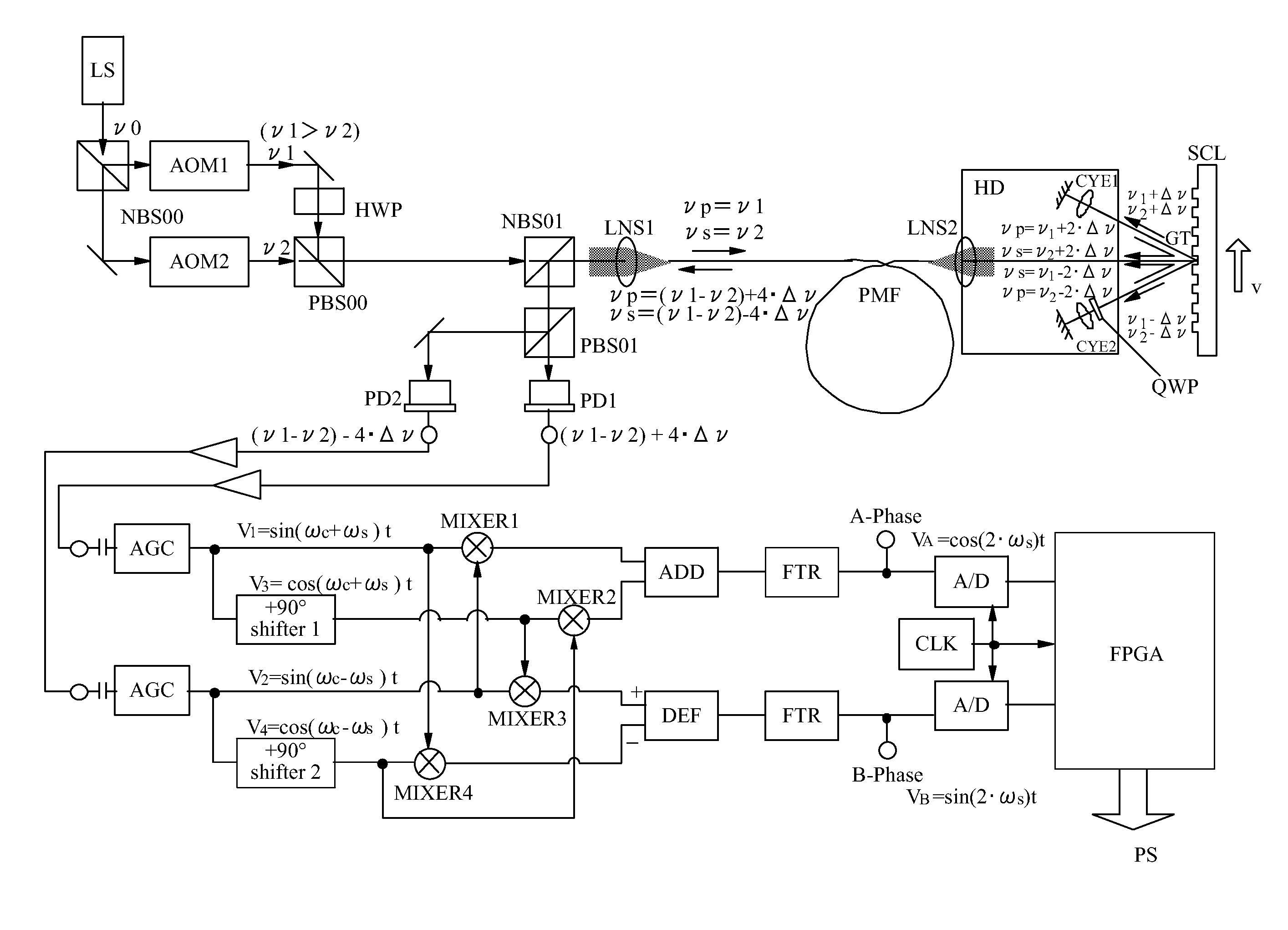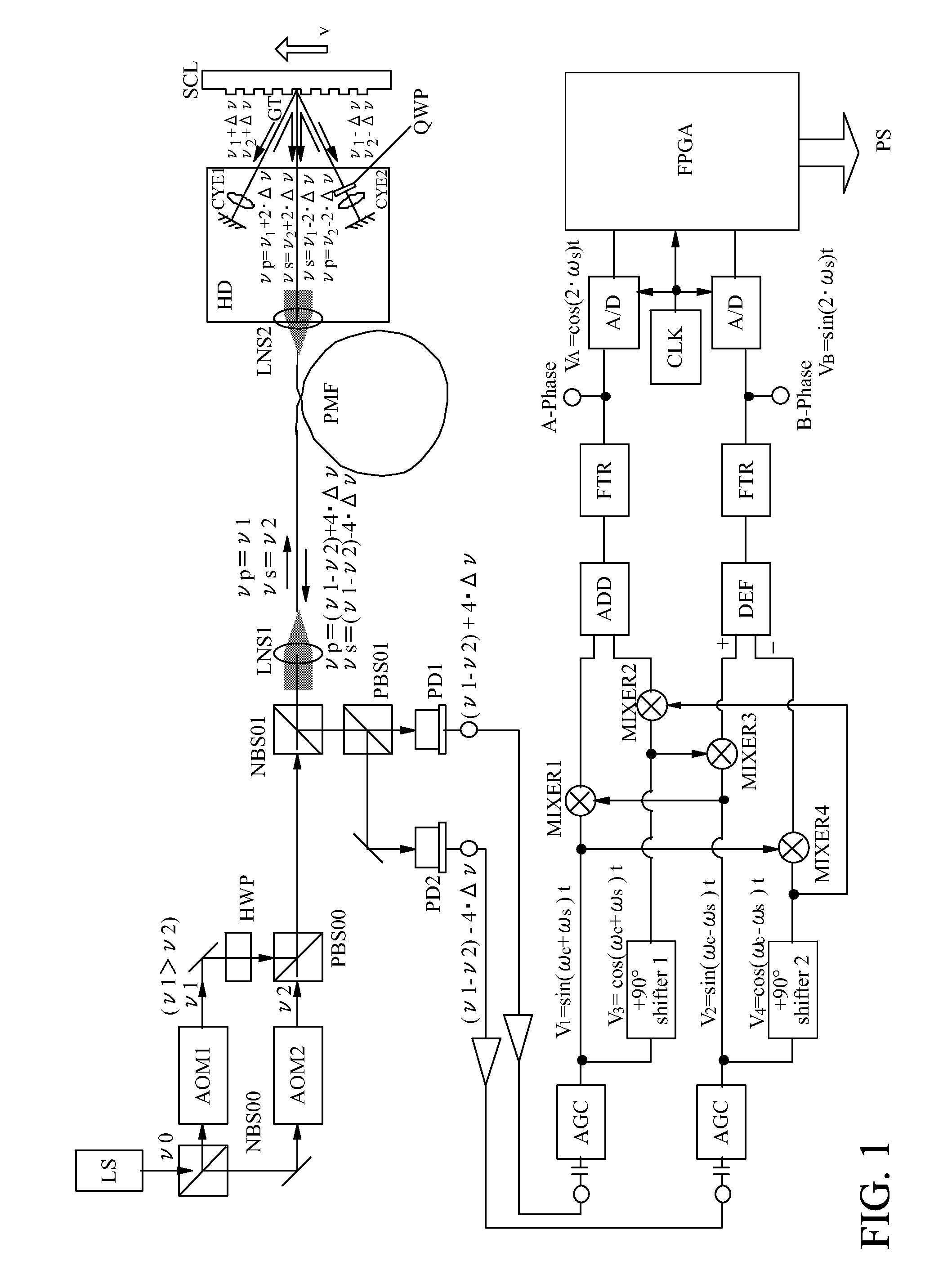Heterodyne interferometer
a technology of interferometer and heterodyne, which is applied in the field of heterodyne interferometer, can solve the problems of insufficient resolution and precision of the above-michelson interferometer, increased heat generation of the circuit, and difficulty in circuit design of the counter and the signal processor, so as to achieve the effect of improving measurement resolution
- Summary
- Abstract
- Description
- Claims
- Application Information
AI Technical Summary
Benefits of technology
Problems solved by technology
Method used
Image
Examples
first embodiment
[0022]FIG. 1 illustrates an interferometer encoder including a diffraction grating as a heterodyne interferometer according to a first embodiment of the present invention.
[0023]A parallel light flux (with a frequency of ν0) that is linearly polarized light emitted in a 0° azimuth emitted from a laser light source LS is split into two by a beam splitter NBS00. A reflection light flux from the beam splitter NBS00 is converted into a light flux having a frequency of ν1=ν0+320 MHz by an acousto-optical element AOM1, and a transmission light flux through the beam splitter NBS00 is converted into a light flux having a frequency of ν2=ν0+300 MHz by an acousto-optical element AOM2. “ν0” is an (original) frequency of the laser light source LS and, for example, is ν0=299792458 / 850×10−9=352.6 THz for a laser light source of 850 nm.
[0024]A polarization plane of one of these two light fluxes is rotated by 90° by a half waveplate HWP, and these two light fluxes are synthesized with each other in ...
second embodiment
[0050]FIG. 2 illustrates a Michelson interferometer as a heterodyne interferometer according to a second embodiment of the present invention.
[0051]A part of the light flux emitted from the two-frequency light source including a laser light source LS, an acousto-optical elements AOM1 and AOM2 similar to the first embodiment is reflected on the non-polarization beam splitter NBS01 and extracted. The extracted light flux (second light) enters the signal generator, and is photoelectrically converted (detected) by a (second) light-receiving element PD0 via a polarizing plate POL0 of a 45° azimuth. This light flux and an output signal (reference frequency signal) from the light-receiving element PD0 have the same reference frequency as a frequency difference (ν1−ν2) of the two-frequency light source.
[0052]On the other hand, the light flux that has transmitted through the non-polarization beam splitter NBS01 enters a Faraday element FR in a detection head HD (irradiator) via a polarization...
third embodiment
[0063]FIG. 3 illustrates a structure of a signal generator in a heterodyne interferometer according to a third embodiment of the present invention. This signal generator is an illustrative improvement configured to reduce an error of the phase shifter for the signal generator of the first and second embodiments.
[0064]Usually, a 90° phase shifter that uses an analog circuit causes a phase error as a frequency of an input signal varies, and thus a final sine signal is likely to contain a frequency component that is twice as high as the heterodyne frequency.
[0065]Accordingly, this embodiment generates a phase shifted signal by shifting a signal having an original phase of 0° at phase shifters (shifter1 and shifter2) by θ≈90°, and generates a signal by adding the signal having the phase of 0° to the phase shifted signal, and a signal by subtracting the signal having the phase of 0° from the phase shifted signal. Since the post-addition signal and the post-subtraction signal have a phase...
PUM
 Login to View More
Login to View More Abstract
Description
Claims
Application Information
 Login to View More
Login to View More - R&D
- Intellectual Property
- Life Sciences
- Materials
- Tech Scout
- Unparalleled Data Quality
- Higher Quality Content
- 60% Fewer Hallucinations
Browse by: Latest US Patents, China's latest patents, Technical Efficacy Thesaurus, Application Domain, Technology Topic, Popular Technical Reports.
© 2025 PatSnap. All rights reserved.Legal|Privacy policy|Modern Slavery Act Transparency Statement|Sitemap|About US| Contact US: help@patsnap.com



